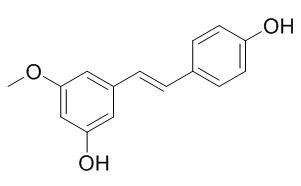Pinostilbene
Pinostilbene has protective effects against 6-hydroxydopamine-induced neurotoxicity in SH-SY5Y cells, it can reduce release of lactate dehydrogenase and activity of caspase-3 triggered by 6-hydroxydopamine (6-OHDA) in a dose-dependent manner. Pinostilbene can significantly inhibit the growth of human colon cancer cells, i.e., HCT116 and HT29, 20 and 40 uM of pinostilbene causes cell cycle arrest at S phase and induces apoptosis in colon cancer cells.
Inquire / Order:
manager@chemfaces.com
Technical Inquiries:
service@chemfaces.com
Tel:
+86-27-84237783
Fax:
+86-27-84254680
Address:
1 Building, No. 83, CheCheng Rd., Wuhan Economic and Technological Development Zone, Wuhan, Hubei 430056, PRC
Providing storage is as stated on the product vial and the vial is kept tightly sealed, the product can be stored for up to
24 months(2-8C).
Wherever possible, you should prepare and use solutions on the same day. However, if you need to make up stock solutions in advance, we recommend that you store the solution as aliquots in tightly sealed vials at -20C. Generally, these will be useable for up to two weeks. Before use, and prior to opening the vial we recommend that you allow your product to equilibrate to room temperature for at least 1 hour.
Need more advice on solubility, usage and handling? Please email to: service@chemfaces.com
The packaging of the product may have turned upside down during transportation, resulting in the natural compounds adhering to the neck or cap of the vial. take the vial out of its packaging and gently shake to let the compounds fall to the bottom of the vial. for liquid products, centrifuge at 200-500 RPM to gather the liquid at the bottom of the vial. try to avoid loss or contamination during handling.
Sci Rep.2023, 13(1):13610.
Nutrients.2017, 10(1)
Eur J Pharmacol.2024, 981:176883.
Drug Dev Res.2022, 83(7):1673-1682.
Pharmaceuticals (Basel).2024 Feb 24;17(3):292.
Current Enzyme Inhibition2023, 19(1):55-64(10)
J Korean Soc Food Sci Nutr2023, 52(7): 750-757
Molecules.2019, 24(6):E1155
Foods.2020, 9(10):1348.
Evid Based Complement Alternat Med.2018, 2018:4580627
Related and Featured Products
J Nutr Biochem. 2010 Jun;21(6):482-9.
Protective effects of pinostilbene, a resveratrol methylated derivative, against 6-hydroxydopamine-induced neurotoxicity in SH-SY5Y cells.[Pubmed:
19443200]
Release of lactate dehydrogenase and activity of caspase-3 triggered by 6-OHDA were significantly reduced by resveratrol and one of the methylated derivatives, Pinostilbene (3,4'-dihydroxy-5-methoxystilbene), in a dose-dependent manner. In addition, Pinostilbene exerted a potent neuroprotective effect with a wider effective concentration range than resveratrol.
METHODS AND RESULTS:
By using high-performance liquid chromatography, we found that uptake of Pinostilbene into SH-SY5Y cells was significantly higher than that of resveratrol. Enhanced bioavailability may thus be a major factor contributing to the neuroprotective activity of Pinostilbene. Moreover, Western blot analysis demonstrated that Pinostilbene markedly attenuated the phosphorylation of JNK and c-Jun triggered by 6-OHDA. Besides, mammalian target of rapamycin kinase may be an intracellular target accounting for the neuroprotective effects of Pinostilbene.
CONCLUSIONS:
Our findings demonstrate the potential of methylated stilbenes in neuroprotection and provide important information for further research in this field.
Mol Nutr Food Res. 2016 Sep;60(9):1924-32.
Identification of pinostilbene as a major colonic metabolite of pterostilbene and its inhibitory effects on colon cancer cells.[Pubmed:
26990242]
Pterostilbene (PTE) is a resveratrol derivative mainly found in blueberries, and it has been shown to inhibit colon carcinogenesis in multiple animal models. To shed light on the mechanism of PTE in inhibiting colon carcinogenesis, we investigated the PTE metabolites in the mouse colon and in the human colon cancer cells.
METHODS AND RESULTS:
CD-1 mice were fed PTE-containing diet for 3 weeks, and colonic content and colonic mucosa were collected and subjected to LC-MS analysis. Pinostilbene (PIN) was identified as a major metabolite of PTE in the mouse colon. Importantly, the level of PIN was found to be approximately equivalent to that of PTE in the colonic mucosa. PIN significantly inhibited the growth of human colon cancer cells, i.e., HCT116 and HT29. These inhibitory effects were similar to those produced by PTE. Moreover, under physiologically relevant conditions, 20 and 40 μM of PIN caused cell cycle arrest at S phase and induced apoptosis in colon cancer cells. These effects were associated with profound modulation of signaling proteins related with cell proliferation and programmed cell death.
CONCLUSION:
Our results demonstrated that PIN is a major metabolite of PTE in the colon of mice fed with PTE, and PIN may play important roles in the anti-colon cancer effects elicited by orally administered PTE.



